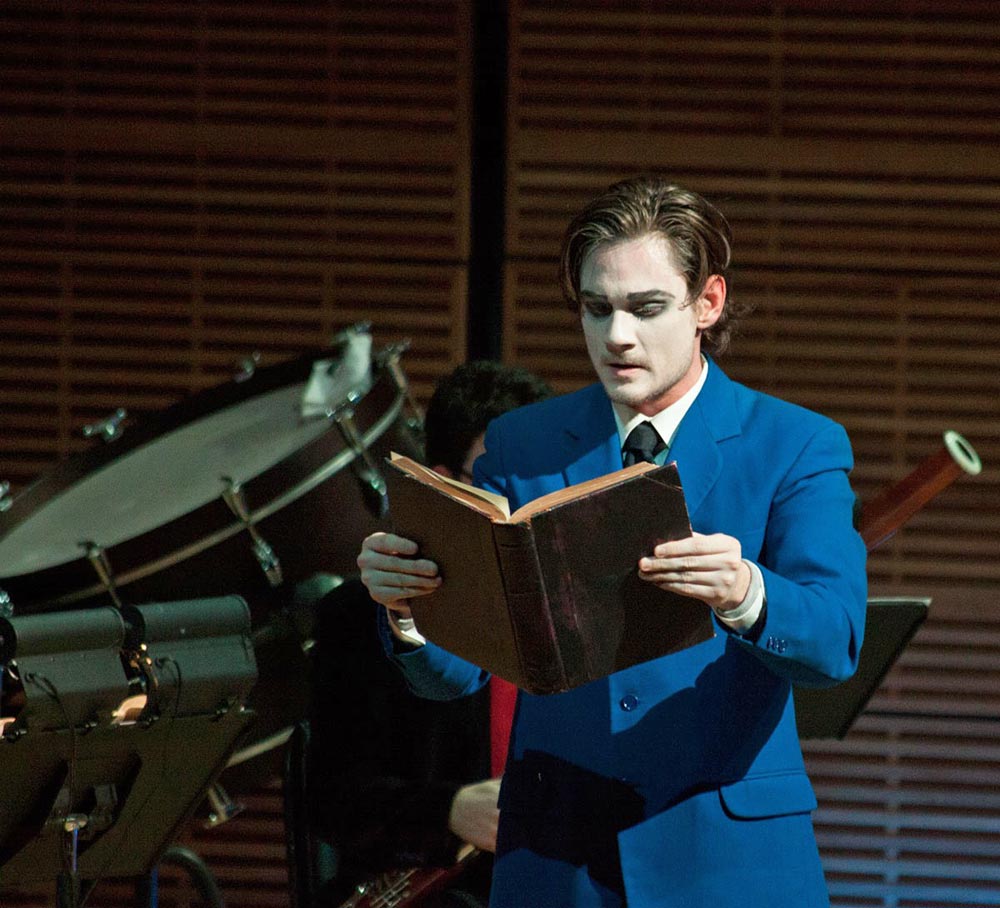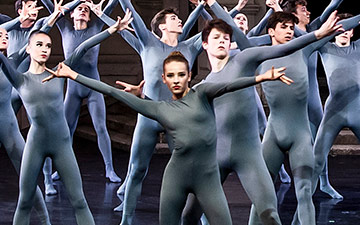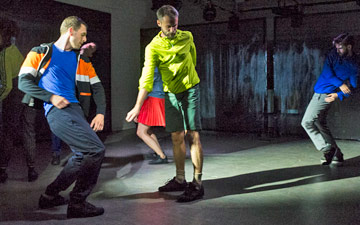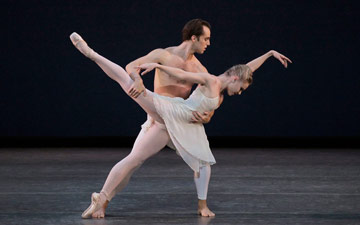
© Dana Astmann. (Click image for larger version)
Yale School of Music/Yale School of Drama/Yale in New York
Yale in New York: The Soldier’s Tale
New York, Zankel Hall at Carnegie Hall
7 April 2014
music.yale.edu
www.carnegiehall.org
Homeward Bound
In 1918, when Stravinsky wrote L’Histoire du Soldat with the Swiss poet Charles-Ferdinand Ramuz, Europe was crawling with shell-shocked soldiers, many of them longing for homes and families that had been obliterated in the deadly years of the First World War. Stravinsky himself had been stranded in Western Europe, cut off from Russia by war and a revolution. In this period of turbulence and strapped finances for the composer – he had no access to his Russian bank account and his Ballets Russes patron, Serge Diaghilev, was in no position to support him – he composed L’Histoire du Soldat, a short, mordant piece of musical theatre, which he hoped would bring him some quick and easy cash. (The plan didn’t really work, because the Spanish ‘Flu kept the show from touring.) The simple format – a narrator, three almost-mute actors, and chamber orchestra – was reminiscent of the fairground shows of his childhood. And, because of Stravinsky’s experience with the Ballets Russes, it had dance. The actors were like mimes, or even puppets, who moved to the music. (A bit like the puppets in his Petrouchka, a ballet also inspired by the fairground.) The dances were choreographed by Ludmilla Pitoev, one of the players in the original cast.
Since that first show in Lausanne in 1918, L’histoire has been revived by everyone from Jiri Kylian to Peter Martins and Eliot Feld, and more recently, in a very effective version, by Lar Lubovitch. There is even a Javanese version, available on YouTube. The staging performed on April 6 at Zankel Hall – one time only, a shame – is the result of a collaborative effort involving several departments at Yale University: the school of music, the school of drama, and the seven-year-old “Yale in New York” series, directed by the clarinetist David Shifrin. (Previously, the series has presented evenings of Prokofiev and Handel, among other things.) The libretto, originally in French, has been re-translated and updated (at times awkwardly) in rhythmic, rhyming verse by Liz Diamond, director of the Yale Repertory Theatre. Five of the seven musicians are currents students. The choreographer, Emily Coates, directs dance studies at the school. L’histoire is an ideal choice for this type of multi-departmental collaboration, simple, direct, surprisingly timely, musically exciting. For the three young actors (all currently enrolled), it offers a remarkable opportunity to make a mark while barely using their voices, usually the actor’s main tool.

© Dana Astmann. (Click image for larger version)
Stravinsky’s is a bitter tale with folk roots, about a soldier (played by the convincingly guileless, agile Tom Pecinka) returning home from the front who is sidetracked by the devil. The seductive stranger (the angular, excitable James Cusati-Moyer, channeling the MC from Cabaret as well as Heath Ledger’s Joker) offers riches beyond the soldier’s wildest imagination. They make a trade; the soldier hands over his violin, the instrument whose raspy sound represents him in Stravinsky’s orchestration. In return he receives a book full of financial secrets. The price he pays is devastating: he loses his mother, his sweetheart, his friends and his soul. He is forced into exile. In one of his only spoken lines, the soldier cries out: “I’m so far beyond rich, ‘super-rich’ now describes me. A super-rich dead man with nothing inside me.” Sounds familiar?
Each time the soldier finds a way to reclaim his violin and attempt a return to his former state, the devil confounds him. Finally, he finds true love with a melancholy princess (Mariko Parker), and a happy ending seems within reach. But temptation – not always financial – returns, and the door to happiness is barred. The message is clear: you can’t go home. Thus it was for Stravinsky as well.

© Dana Astmann. (Click image for larger version)
The Yale production was true to the spirit of the piece and vivid, if slightly overplayed in certain aspects. More simplicity would have suited the delivery of the narrator (the well-known Broadway actor Michael Cerveris, a Yale alumnus), which veered toward over-interpretation of the text. The actor lingered on certain words with extra emphasis as if to alert the audience to the importance of this or that passage. A lighter touch would have suited the story’s folk – and paradoxically cosmopolitan – atmosphere better. As would a slightly less hammy interpretation of the Devil’s character, with fewer double-takes and leering grins. With a piece like this, it’s a question of less rather than more. The production needs to settle, to find the right overall balance. But much of Coates’ choreography, especially for the soldier, and later the princess, creates a convincing counterpart to Stravinsky’s airy, slightly acerbic, syncopated and jazzy score. Pecinka’s jerky, stiff-legged walk, especially, evokes the marionette theatre, and somehow, the essential purity of his soul.
A longer orchestral passage allows Coates to play with various dance forms, from the Charleston to the tango. This is the most serious dancing of the night, and the young, light-footed actors pull it off with flair. It’s especially moving to see non-dancers dancing on-stage; the three Yale drama students move with grace and they’re well-rehearsed, but still, they look more like us than like the sylphs of City Ballet. (Though I suspect that Ms. Parker has had more than a glancing acquaintance with the dance studio.) But the musicians – most especially Shifrin on clarinet and Ani Kavafian on the violin – are anything but amateurs; they play Stravinsky’s music with the crispness and melodic élan that makes The Soldier’s Tale linger in one’s mind like a familiar, sharp-edged memory.

















You must be logged in to post a comment.